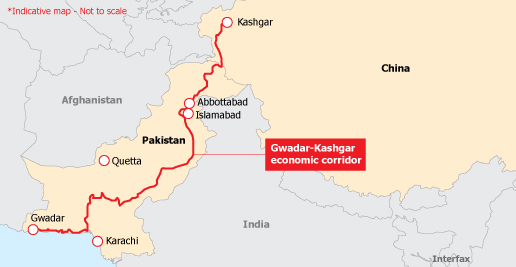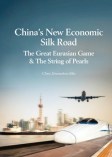Iran Completes First Phase of Chabahar Port and International North-South Transport Corridor
Iran has held a ceremony to launch the first successfully completed phase of the Chabahar Port, which will be part of the International North-South Transportation Corridor (INSTC) linking India through to markets in Russia and the Eurasian Economic Union (EAEU).
Iran has recently completed negotiations with the EAEU concerning a Free Trade deal, with a ratified document expected to be released next year. India is also currently negotiating its own FTA with the EAEU, while both Iran and India are also exploring their own FTA a situation that will make the INSTC an extremely valuable proposition.
![]() Related: Russia Connecting With India Via The INSTC
Related: Russia Connecting With India Via The INSTC
The Chabahar project itself is a joint Iranian-Indian investment, costing an estimated US$1 billion including $235 million from India. It has more than tripled the Chabahar Port’s capacity to 8.5 million tons a year. In October, India sent its first consignment of wheat to Afghanistan through Chabahar on the Gulf of Oman – Iran’s closest route to the Indian Ocean.
President Rouhani, presiding over the formalities, emphasized that the project was specifically important given that it connected the trade corridors that pass through Iran to the ocean. “This port is also significant from the political point of view given that it connects Iran with its eastern and northern neighbors and, at a later stage, European states,” Rouhani said.
The Iranian Minister of Road and Urban Development Abbas Akhoundi said Chabahar will become a competitive and modern port that can play the role of a gateway to the countries of the region, and that the port can accelerate the development of the regional countries and create an economic boom in the region. Following the connection of Chabahar to Iran’s railroad network, he said, the port will be able to play a great role in Iran’s speedy development and, also, will provide Afghanistan and Central Asian countries with access to oceanic routes. Chabahar can also accommodate the new category of 100,000-ton ships.
The overall development project is planned in four phases and is expected to bring the port’s total annual cargo capacity to 82 million tons – ten times the current capacity, with Tehran and Delhi planning to utilize Chabahar for transshipment to Afghanistan and Central Asia.
India, Iran and Afghanistan have signed an agreement to give Indian goods, heading toward Central Asia and Afghanistan, preferential treatment and tariff reductions at Chabahar. From the geographical perspective, Chabahar provides India with an easier land-sea route to Afghanistan. The Indian government has committed US$500 million to the entire Chabahar project, with an aim to join an increasingly important transport corridor to resource-rich regional countries.
Massive investment plans are already on the cards, with the Indian government offering to build a sprawling artery of roads and railways which is estimated to cost US$15 billion, and is designed to bypass Pakistan, which lies between India and Iran and is not especially friendly to either. To this end, India has finalized a plan to build a 900km railroad from the Afghan province of Bamiyan to Chabahar Port. It has also already spent US$100 million on building a 220km road in the Afghan province of Nimruz, which will be extended to Chabahar.

Once the development project is complete, Chabahar will be linked with the International North-South Transportation Corridor (INSTC), which currently stretches from the Iranian port of Bandar Abbas in the Persian Gulf to Russia, Eurasia and Europe.
However, Chabahar faces competition. Just 72km east along the coast is the Chinese invested, Pakistan based Port of Gwadar, which the Chinese wish to utilize to provide an oceanic port for products being manufactured in its Xinjiang Province, which borders Pakistan.

Meanwhile, the Chinese-Pakistan Economic Corridor (CPEC) includes disputed territories claimed by India, which is one reason India has thus far been reluctant to sign up to China’s Belt & Road Initiative. Indeed, the CPEC concept has also been proving controversial in Pakistan itself, with some officials in both Military and Government wary of over-dependence on Chinese aid, a burgeoning debt to Beijing and fears of ultimate Chinese control – China has already been a major provider of energy, including nuclear power plants, in Pakistan. Islamabad maintains a growing unease that Pakistan could become a vassal state, de facto governed from Beijing. These fears are slowing down progress at Gwadar, and along the connecting routes through to Xinjiang, meaning that of the competing Ports, it appears Chabahar is likely to become the more internationalized and especially if Iran is able to normalise trade relations with the EU.
About Us
Silk Road Briefing is produced and written by Dezan Shira & Associates. The firm provides governments and corporate businesses worldwide with strategic, legal, tax and operational advisory services to their SMEs and MNCs investing throughout Eurasia and has 28 offices across China, India, Russia and the ASEAN nations, and partner firms in Central Asia. We have specific and long term experience in China and the OBOR countries. For assistance with OBOR related issues, please contact the firm at silkroad@dezshira.com or visit the practice at www.dezshira.com
 Related Reading:
Related Reading:
![]() Iran-Russia Rail Corridor Direct to Europe
Iran-Russia Rail Corridor Direct to Europe
Silk Road and OBOR Business Intelligence
Dezan Shira & Associates´ Silk Road and OBOR investment brochure offers an introduction to the region and an overview of the services provided by the firm. It is Dezan Shira´s mission to guide investors through the Silk Road´s complex regulatory environment and assist with all aspects of establishing, maintaining and growing business operations in the region.
China’s New Economic Silk Road
This unique and currently only available study into the proposed Silk Road Economic Belt examines the institutional, financial and infrastructure projects that are currently underway and in the planning stage across the entire region. Covering over 60 countries, this book explores the regional reforms, potential problems, opportunities and longer term impact that the Silk Road will have upon Asia, Africa, the Middle East, Europe and the United States.







